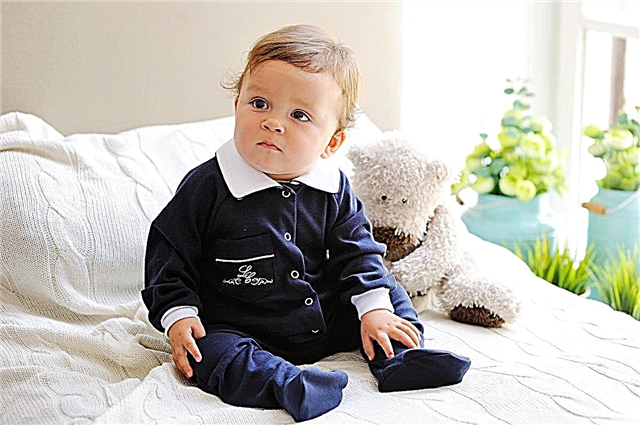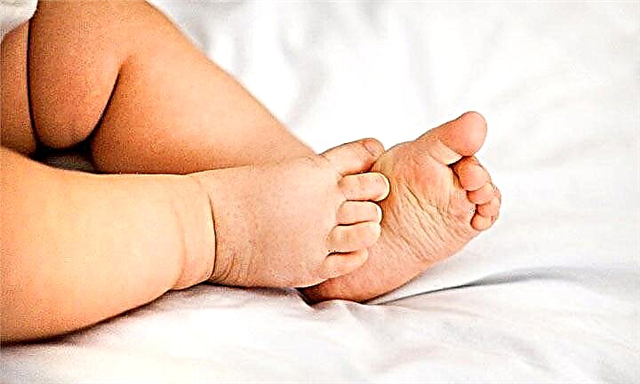
An infant's hemoglobin can decrease for several reasons. And before panicking, seeing the indicator below the norm in the blood test form, parents should find out what is dangerous for babies and how to raise hemoglobin in a child up to one year old.
What hemoglobin is considered low
Hemoglobin is a complex iron-containing protein that is vital for a person at any age, and especially for an infant. It is found in red blood cells and is designed to bind oxygen and transport it to tissues, and then to bind carbon dioxide and transport it to the lungs. Thus, without a sufficient amount of hemoglobin, gas exchange in the child's body will be disrupted. That is why it is important to control its quantity, avoiding a strong decrease.

Normally, in a newly born baby, hemoglobin is very high and is 180-220 g / l, and from the second week of life it begins to decrease, reaching 110-130 g / l by 12 months.
The following indicators are considered the lower limit of the hemoglobin norm in the blood of a child of the first year of life:
If hemoglobin is lowered slightly, this will alert the doctor, but will not yet require treatment, since a slight deviation can be corrected by some changes in diet and lifestyle. If the hemoglobin level in babies of the first year of life is greatly underestimated, for example, immediately after birth below 130 g / l or at 9 months below 100 g / l, this is the reason for a more detailed examination in order to identify the cause of the decrease, and then prescribe appropriate therapy.

Reasons for downgrading
The most common cause of low hemoglobin in a child's blood is anemia caused by a lack of iron.
In infants, such a deficiency often causes anemia in the mother, which appears during pregnancy or during breastfeeding. Because of this state, the baby cannot accumulate iron during intrauterine development and does not receive it with breast milk, which leads to a decrease in the level of hemoglobin.
For the opinion of Dr. Komarovsky about the hemoglobin level in a pregnant and lactating mother, see the issue below:
Also, iron deficiency in infants can be caused by too late introduction of complementary foods, refusal of a child older than 6 months from meat or fruit complementary foods, a vegetarian diet of a nursing mother, and insufficient activity of the baby.
Other causes of low hemoglobin in children under one year old are:
- Complications of pregnancy and childbirth.
- Hasty cutting of the umbilical cord.
- Prematurity.
- Multiple pregnancy.
- Anemia caused by deficiency of vitamins B9 and B12.
- Hemolytic anemia.
- Bleeding - both acute and chronic.
- Postponed operation.
- Genetic abnormalities in the formation of erythrocytes.
- Infectious disease.
- Child development pathologies.

Symptoms of anemia
To suspect a too low hemoglobin level in an infant, the following signs will help:
- Lethargy, drowsiness and rapid onset of fatigue.
- Pale skin on cheeks and palms.
- Capricious behavior.
- Dry skin and flaking.
- Worsening sleep.
- Refusal to eat.
- The appearance of white spots and stripes on the nails.
- The appearance of circles under the eyes.
- Increased body temperature without acute respiratory infections, allergies or other diseases.
- Frequent colds and SARS.
Why low hemoglobin is dangerous
An insufficient amount of hemoglobin in the blood leads to the fact that the tissues receive less oxygen. This negatively affects the development of the child, his general condition, sleep and appetite. If you do not respond in time to low hemoglobin, this will lead to a lag in mental and physical development, as well as to impaired brain activity.

Treatment
To increase hemoglobin in a nursing infant, an integrated approach is important. Having established the cause of this situation, the doctor will prescribe medications, and also recommend how to change the nutrition of the baby or his mother. It is also important to often walk with the baby and limit the child from stress.
Medicines
If the hemoglobin level is critically low, the child will be hospitalized and treated in the hospital. Otherwise, the doctor will prescribe drugs to be taken at home.
For iron deficiency anemia, these medications are medications containing iron. Examples of such medications are Aktiferrin, Maltofer, Ferrum Lek or Ferronal 35... They are prescribed for a long period - at least 1-3 months.
Vitamin B12 and folic acid with low hemoglobin are prescribed in cases where the cause of anemia is their deficiency.
Any of these drugs should be prescribed by a doctor, making sure that there are indications for their use and that there are no possible contraindications.
It is unacceptable to give your child iron supplements on your own. In addition, in some children, when taking iron-containing drugs, side reactions occur, for example, regurgitation, skin rash, vomiting and others. In such a situation, you should stop taking and tell the pediatrician about the side effects to select another medication.
What to eat
When breastfeeding, the mother should adjust the diet, by adding foods that contain quite a lot of iron:
- Beef.
- Liver.
- Lean pork.
- Pomegranates.
- Buckwheat.
- Wheat and barley.
- Apples.
- Lentils.
- Pistachios and other nuts.
- Oatmeal.
- Beets.
- Dried apricots.
- Blueberries.
- Turkey.
It is important to remember that the absorption of iron from food is improved under the influence of ascorbic or lactic acid. At the same time, the iron contained in meat products is best absorbed. The presence in food of soy protein, polyphenols from legumes, nuts, tea, as well as excess dietary fiber and calcium, on the contrary, impairs the absorption of iron.
With artificial feeding, you should discuss with the pediatrician the issue of the earlier introduction of complementary foods, in particular, fruit and meat purees.

Komarovsky's opinion
A popular pediatrician confirms that iron deficiency anemia is the most common reason for a decrease in hemoglobin in an infant. He explains this by the depletion of iron stores in a child by 5-6 months of age. For this reason, Komarovsky advises all babies at this age to do a clinical blood test, especially if the mother had low hemoglobin during the gestation period.
With regard to treatment, a renowned physician claims that iron-rich foods only help prevent a decrease in hemoglobin or delay the progression of anemia. If the hemoglobin level in the infant is already lowered, Komarovsky recommends adhering to the recommendations of his attending physician and giving the baby iron supplements.
The complete release of the program of Evgeny Komarovsky, which details the topic of low hemoglobin in children, is detailed below:
Prevention
To prevent a decrease in hemoglobin in a child under one year old, it is recommended:
- Treat anemia in the expectant mother during gestation. A woman should pay attention to her diet, enriching it with iron-containing foods so that the fetus can accumulate enough iron by the time of birth. Also, according to indications, pregnant women are prescribed multivitamins and iron preparations.
- Breastfeed your baby because mother's milk contains iron, which is absorbed much better than iron-fortified formula. This is also facilitated by the content of the enzyme lactoferrin in breast milk. Its presence not only helps to assimilate iron from human milk, but also contributes to better absorption of iron from complementary foods after its introduction (this leads to the recommendation to continue breastfeeding for at least 1-1.5 years).
- For a long time regularly walking with the baby on the street. Thanks to such walks, the blood will be enriched with oxygen, which will stimulate the production of red blood cells.
- Introduce complementary foods in a timely manner, starting at 6 months of age, when the infant's own iron stores run out. At the same time, it is important to follow modern recommendations, since the presence of semolina and cow's milk in the diet of a child up to one year old increases the risk of anemia.
- Give your baby a blood test at 6 months to assess hemoglobin levels. It is also recommended to check the ferritin content, as this will help determine if the crumbs have iron stores.




